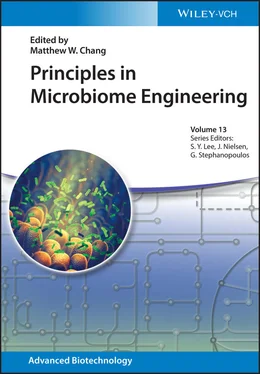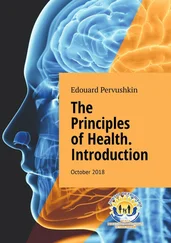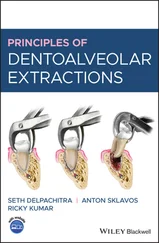Principles in Microbiome Engineering
Здесь есть возможность читать онлайн «Principles in Microbiome Engineering» — ознакомительный отрывок электронной книги совершенно бесплатно, а после прочтения отрывка купить полную версию. В некоторых случаях можно слушать аудио, скачать через торрент в формате fb2 и присутствует краткое содержание. Жанр: unrecognised, на английском языке. Описание произведения, (предисловие) а так же отзывы посетителей доступны на портале библиотеки ЛибКат.
- Название:Principles in Microbiome Engineering
- Автор:
- Жанр:
- Год:неизвестен
- ISBN:нет данных
- Рейтинг книги:5 / 5. Голосов: 1
-
Избранное:Добавить в избранное
- Отзывы:
-
Ваша оценка:
- 100
- 1
- 2
- 3
- 4
- 5
Principles in Microbiome Engineering: краткое содержание, описание и аннотация
Предлагаем к чтению аннотацию, описание, краткое содержание или предисловие (зависит от того, что написал сам автор книги «Principles in Microbiome Engineering»). Если вы не нашли необходимую информацию о книге — напишите в комментариях, мы постараемся отыскать её.
Provides an overview of the techniques and applications insight into the complex composition and interactions of microbiomes Principles in Microbiome Engineering
Principles in Microbiome Engineering
Principles in Microbiome Engineering — читать онлайн ознакомительный отрывок
Ниже представлен текст книги, разбитый по страницам. Система сохранения места последней прочитанной страницы, позволяет с удобством читать онлайн бесплатно книгу «Principles in Microbiome Engineering», без необходимости каждый раз заново искать на чём Вы остановились. Поставьте закладку, и сможете в любой момент перейти на страницу, на которой закончили чтение.
Интервал:
Закладка:
Love, J. Ch. (ed.)
Micro‐ and Nanosystems for Biotechnology
2016
Print ISBN: 978‐3‐527‐33281‐6
Wittmann, Ch., Liao, J.C. (eds.)
Industrial Biotechnology Microorganisms (2 Volumes)
2017
Print ISBN: 978‐3‐527‐34179‐5
Wittmann, Ch., Liao, J.C. (eds.)
Industrial Biotechnology Products and Processes
2017
Print ISBN: 978‐3‐527‐34181‐8
Nielsen, J., Hohmann, S. (eds.)
Systems Biology
2017
Print ISBN: 978‐3‐527‐33558‐9
Smolke, C.
Synthetic Biology
Parts, Devices, and Applications
2018
Print ISBN: 978‐3‐527‐33075‐1
Chang, H. N
Emerging Areas in Bioengineering
2018
Print ISBN: 978‐3‐527‐34088‐0
Lee, M. L., Kildgaard, H. F.
Cell Culture Engineering Recombinant Protein Production
2019
Print ISBN: 978‐3‐527‐81140‐3
Rehm. B. H. A., Moradali, M. F.
Biopolymers for Biomedical and Biotechnological Applications
2021
Print ISBN: 978‐3‐527‐34530‐4
Hudson, P.
Cyanobacteria Biotechnology
2021
Print ISBN: 978‐3‐527‐34714‐8
Lee, S.Y., Nielsen, J., Stephanopoulos, G. (Eds.)
Metabolic Engineering
2021
Print ISBN: 978‐3‐527‐34662‐2
Principles in Microbiome Engineering
Edited by
Matthew W. Chang

Volume Editor
Prof. Dr. Matthew W. ChangNational University of Singapore Department of Biochemistry 28 Medical Drive 117456 Singapore Singapore
Series Editors
Prof. Dr. Sang Y. LeeKAIST 373‐1, Guseong‐Dong 291 Daehak‐ro, Yuseong‐gu 34141 Daejeon South Korea
Prof. Dr. Jens NielsenChalmers University Department of Chemical and Biological Engineering Kemivägen 10 412 96 Göteborg Sweden
Prof. Dr. Gregory StephanopoulosMassachusetts Institute of Technology Department of Chemical Engineering Massachusetts Ave 77 Cambridge, MA 02139 United States
Cover Image:© shutterstock
All books published by WILEY‐VCHare carefully produced. Nevertheless, authors, editors, and publisher do not warrant the information contained in these books, including this book, to be free of errors. Readers are advised to keep in mind that statements, data, illustrations, procedural details or other items may inadvertently be inaccurate.
Library of Congress Card No.:applied for
British Library Cataloguing‐in‐Publication DataA catalogue record for this book is available from the British Library.
Bibliographic information published by the Deutsche NationalbibliothekThe Deutsche Nationalbibliothek lists this publication in the Deutsche Nationalbibliografie; detailed bibliographic data are available on the Internet at < http://dnb.d-nb.de>.
© 2022 WILEY‐VCH GmbH, Boschstrasse 12, 69469 Weinheim, Germany.
All rights reserved (including those of translation into other languages). No part of this book may be reproduced in any form – by photoprinting, microfilm, or any other means – nor transmitted or translated into a machine language without written permission from the publishers. Registered names, trademarks, etc. used in this book, even when not specifically marked as such, are not to be considered unprotected by law.
Print ISBN:978‐3‐527‐34725‐4 ePDF ISBN:978‐3‐527‐82547‐9 ePub ISBN:978‐3‐527‐82548‐6 oBook ISBN:978‐3‐527‐82546‐2
Cover DesignAdam-Design, Weinheim, Germany
Preface
Though unseen to the naked eye, microbiomes represent an invisible universe with much yet to be explored. From the diverse microbial communities found within our own bodies all the way to the soil's depths, the omnipresence of these microbiomes underlies their vital role in mediating biological processes. By offering a means to harness these microbes for societal benefit, microbiome engineering can pave the way for crucial interventions in everything from disease treatment to agricultural productivity.
Given the intricacy of interactions among microbes, it would be wise to comprehensively compile our state‐of‐the‐art knowledge on microbiome engineering. Written by leading experts, the volume's 10 chapters touch upon fundamental aspects – such as the microbiome's wide‐ranging influence on human health, disease, and agriculture; methods to engineer microbiomes for therapeutic and diagnostic applications, as well as insights into recent research directions that are shaping the field.
With probiotics capturing public imagination in recent years, Chapter 1aptly introduces our current understanding of the human microbiome through the lens of diet and nutrition. Chapter 2builds upon this foundation by exploring how microbiome engineering can modulate common metabolic disorders from diabetes to cardiovascular disease.
While microbes are popularly perceived as “villains” in the quest for health, Chapter 3challenges this notion by describing the myriad ways microbes can be repurposed to sense, respond to, and even treat diseases. Rounding out the volume's initial focus on human health, Chapter 4details specific considerations when engineering probiotics to be better adapted to the gut.
Chapter 5moves onto another equally fascinating – and important – application of microbiome engineering: precision agriculture, where minute variations in crop data are gathered and leveraged to improve yield and quality. Given the delicate balance of microbiomes, Chapter 6provides an overview of the different biological sensors being developed to detect even the slightest of perturbations, such as riboswitches and transcription factors.
Meanwhile, Chapter 7focuses on how synergistic interactions among microorganisms can be further enhanced by engineering synthetic microbial consortia. Already ubiquitous in nature, advancing the design of microbial consortia could lead to breakthroughs in bioprocessing and bioremediation, among others. Proving that waste can indeed be turned into wonder, Chapter 8describes the emerging treatment that is fecal microbiota transplantation, from the protocols involved to its clinical applications.
With early‐life microbiota increasingly linked to long‐term health and disease, Chapter 9shines a spotlight on the maternal microbiota and the many factors affecting its impact on newborn infants. Finally, this volume concludes in Chapter 10by diving deep into a powerful technique in the microbiome engineering toolkit: transcription factor‐based biosensors, first introduced in Chapter 6.
I would like to extend my deepest gratitude to the experts at the forefront of microbiome engineering for their contributions. By sharing their insights through the written word, I hope that this volume will be an indispensable resource that new generations of researchers can refer to as they add to the growing body of knowledge on microbiome engineering.
| Singapore, April 2022 | Matthew W. Chang National University of Singapore |
1 Diet‐Based Microbiome Modulation: You are What You Eat
Jiashu Li, Zeyang Qu, Feng Liu, Hao Jing, Yu Pan, Siyu Guo and Chun Loong Ho
Читать дальшеИнтервал:
Закладка:
Похожие книги на «Principles in Microbiome Engineering»
Представляем Вашему вниманию похожие книги на «Principles in Microbiome Engineering» списком для выбора. Мы отобрали схожую по названию и смыслу литературу в надежде предоставить читателям больше вариантов отыскать новые, интересные, ещё непрочитанные произведения.
Обсуждение, отзывы о книге «Principles in Microbiome Engineering» и просто собственные мнения читателей. Оставьте ваши комментарии, напишите, что Вы думаете о произведении, его смысле или главных героях. Укажите что конкретно понравилось, а что нет, и почему Вы так считаете.












